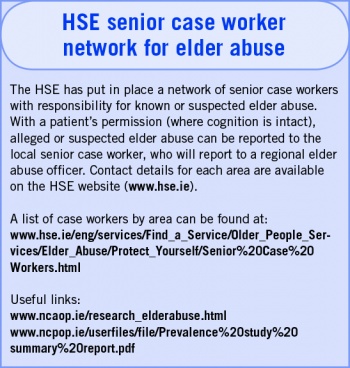GENERAL MEDICINE
GERIATRIC MEDICINE
Knowing the signs of abuse in the elderly
Elder abuse represents an uncommon but important phenomenon, which may go undetected unless clinicians are aware of the risk factors and the signs
March 1, 2012
-
A 76-year-old lady presents to the surgery with her son, who is concerned by his mother’s increasing agitation and irritability. You have known her for some years. She is a retired school principal, widowed, and is currently living with this son who acts as carer. She has a history of ischaemic heart disease, rheumatoid arthritis and a recent diagnosis of dementia, likely with a mixed Alzheimer’s and vascular aetiology. On examination you notice a two inch by four inch scarlet-coloured bruise in her epigastrium and a one inch by one inch greenish yellow bruise on the dorsum of her left arm. Could this be elder abuse, and what should be done about it?
Definition and prevalence
Elder abuse is defined as a single or repeated act or lack of appropriate action occurring within any relationship where there is an expectation of trust, which causes harm or distress to an older person, or violates their human and civil rights.1
International experience suggests a prevalence rate in the community of 3-10%.2 An Irish survey by the National Council for Protection of Older People estimated a prevalence of 4%, ie. 18,000 people affected.3 The true prevalence may be higher – when asked, 52% of a small group of Irish carers for people with dementia admitted some form of abuse.4 Direct questioning of elderly patients may also underestimate abuse.5
Furthermore, the Irish population is ageing – the number of people over 65 will reach 33% of the population by 2041.6 Elderly people who are physically abused or who experience caregiver neglect have three times the mortality of those never abused.7 Abuse represents a widespread problem with serious consequences: for these reasons elder abuse was recognised as a ‘hot topic’ at the 2011 annual general meeting of the ICGP.
Types of abuse
There are a number of recognised types of elder abuse. Neglect may consist of ignoring physical or emotional needs, while psychological abuse includes acts of humiliation, infantilisation, or controlling the patient. Physical abuse may take the form of hitting or restraining the patient, while sexual abuse includes unwanted intimate contact and/or rape. Financial abuse pertains to accessing a person’s accounts without their permission, or pressuring them to spend money not in their own interests. Internationally, the commonest types of abuse are neglect, followed by psychological abuse and financial abuse.8
There is a similar pattern in Ireland, with neglect and financial abuse being most common. Sexual abuse is least common.3
Barriers to detection of abuse
Ninety percent of US physicians feel that elder mistreatment is difficult to detect.9 This can be for a number of reasons: older adults are unlikely to report abuse.10 Patients may be embarrassed, afraid of the consequences for their carer, or may fear the consequences when the carer finds out about disclosure. They may also worry about possible relocation to long-term care. Communication may also be impaired by cognitive impairment.
Psychological abuse is especially difficult to detect: when it presents as apathy or depression it may be mistaken for a grief reaction or cognitive impairment. Where neglect or verbal abuse is suspected it is often difficult to ascertain what is a normal or appropriate relationship for this carer and the elder, as it could be an interpersonal disagreement. However, it is important to be vigilant since early detection and intervention can substantially decrease the associated morbidity and mortality.
There are a number of screening tools available for elder abuse but they suffer from limitations, including time taken to administer and training for their use.11 Knowledge of risk situations is the strongest factor predicting a diagnosis of abuse by GPs, with those who read articles on elder abuse being four times more likely to diagnose abuse than those who did not.12 Older adults are two to three times more likely to visit their GP than younger individuals,13 suggesting that an awareness of risk factors and prevalence is imperative.
Risk factors for abuse
Risk factors may be classified according to patient, carer, or the environment. There is some evidence that risk factors differ according to the type of abuse being perpetrated.
With respect to patients, dementia, depression, malnutrition, female sex and age > 85 are risk factors for mistreatment.7,14 Social isolation or emotional dependence of the care receiver, especially in the setting of dementia, may be indicators.5,7 Physical disability has been shown to correlate with abuse as the subject has an impaired ability to defend themselves.7,15
In terms of carers, mental health problems including anxiety, alcohol or substance abuse, poor premorbid relationship and a lack of understanding of the elder’s medical condition can all contribute. Abusers are more likely to find the behaviour of their dependant a problem than non-abusers.16
Lastly, regarding environment, poor social supports are consistently associated with abusive situations.17 In over 50% of cases reported to the national elder abuse network, the alleged abuser lived with the client. Family members such as an adult child, spouse or other relative were most likely to be the perpetrator.18 In institutional settings, high staff turnover and poor staff attitudes towards the patients have been associated with abuse.19

